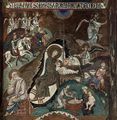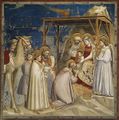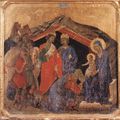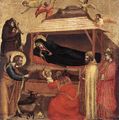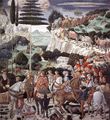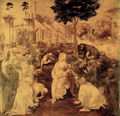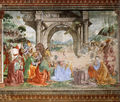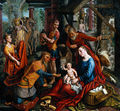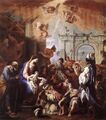Category:Adoration of the Magi (subject)
- BACK to the EVENTS--INDEX
- BACK to the GOSPEL OF MATTHEW -- PROTOEVANGELIUM OF JAMES
- BACK to JESUS OF NAZARETH -- MAGI -- HEROD THE GREAT -- MARY OF NAZARETH -- JOSEPH OF NAZARETH
The Adoration of the Magi refers to an episode in the lives of Jesus of Nazareth, and his parents, Mary of Nazareth and Joseph of Nazareth, as narrated only in the Gospel of Matthew (2:1-12).
- Nativity of Jesus : Genealogy of Jesus -- Annunciation to Mary -- Annunciation to Joseph -- Visitation of Mary -- Birth of Jesus -- Adoration of the Shepherds -- Adoration of the Magi -- Circumcision of Jesus -- Presentation of Jesus at the Temple -- Massacre of the Innocents -- Flight into Egypt
< Life of Jesus : Nativity of Jesus -- Jesus' Hidden Years -- Ministry of Jesus (Parables of Jesus, Miracles of Jesus) -- Passion of Jesus -- Resurrection of Jesus -- Relics of Jesus >
< Life of Mary of Nazareth : Expulsion of Joachim from the Temple -- Annunciation to Anne and Joachim -- Birth of Mary -- Girlhood of Mary (Education of the Virgin, Presentation of Mary at the Temple) -- Marriage of Mary and Joseph -- Annunciation to Mary -- Visitation of Mary -- Birth of Jesus -- Adoration of the Shepherds -- Adoration of the Magi -- Circumcision of Jesus -- Presentation of Jesus at the Temple -- Massacre of the Innocents -- Flight into Egypt -- Jesus among the Doctors -- Death of Joseph of Nazareth -- Wedding at Cana -- Jesus' True Relatives -- Hometown Rejection -- Crucifixion of Jesus -- Resurrection of Jesus -- Ascension of Jesus -- Gathering of the Twelve at Jerusalem -- Christian Pentecost -- Death and Assumption of Mary -- Relics of Mary of Nazareth >
Overview
According to the Gospel of Matthew, a group of "wise men" came from the east following a star, to visit the newborn messiah. They stopped by King Herod, who asked them to report their findings but whose real intention was only to kill the rival "king." The Magi finally arrived to Bethlehem delivering their gifts (gold, frankincense and myrrh) to the baby Jesus. Warned in a dream, they did not visit Herod again but took a different route on their way back home.
The reference to the "star" might be related to the memory of the previous appearance of Halley's Comet in October 12 BCE (the comet was visible again in January 66 CE).
The Protoevangelium of James repeats almost verbatim the Matthew narrative, except that Jesus was born in a "cave" and it was there that the star led the Magi.
Later Christian tradition embellished the episode, and a series of legends began to flourish about the identity and whereabouts of the "three" Magi, who were described as "kings" coming from the East.
Around 1364 the Historia Trium Regum by John of Hildesheim collected all traditions into a long and detailed narratives, which became standard in Western Christianity. At the end of the 15th century, the Historia Trium Regum would be among the first printed books.
Adoration of the Magi, in ancient sources
Gospel of Matthew
- Genealogy of Jesus -> Annunciation to Joseph -> Birth of Jesus -> Adoration of the Magi -> Massacre of the Innocents -> Flight into Egypt -> Baptism of Jesus -> ...
Mt 2:1-12 (NRSV) -- [1] In the time of King Herod, after Jesus was born in Bethlehem of Judea, wise men from the East came to Jerusalem, [2] asking, "Where is the child who has been born king of the Jews? For we observed his star at its rising, and have come to pay him homage." [3] When King Herod heard this, he was frightened, and all Jerusalem with him; [4] and calling together all the chief priests and scribes of the people, he inquired of them where the Messiah was to be born. [5] They told him, "In Bethlehem of Judea; for so it has been written by the prophet: [6] 'And you, Bethlehem, in the land of Judah, are by no means least among the rulers of Judah; for from you shall come a ruler who is to shepherd my people Israel.'" [7] Then Herod secretly called for the wise men and learned from them the exact time when the star had appeared. 8 Then he sent them to Bethlehem, saying, "Go and search diligently for the child; and when you have found him, bring me word so that I may also go and pay him homage." [9] When they had heard the king, they set out; and there, ahead of them, went the star that they had seen at its rising, until it stopped over the place where the child was. [10] When they saw that the star had stopped, they were overwhelmed with joy. [11] On entering the house, they saw the child with Mary his mother; and they knelt down and paid him homage. Then, opening their treasure chests, they offered him gifts of gold, frankincense, and myrrh. [12] And having been warned in a dream not to return to Herod, they left for their own country by another road.
Cf. Protoevangelium of James
[21] And, behold, Joseph was ready to go into Judea. And there was a great commotion in Bethlehem of Judea, for Magi came, saying: Where is he that is born king of the Jews? For we have seen his star in the east, and have come to worship him. And when Herod heard, he was much disturbed, and sent officers to the Magi. And he sent for the priests, and examined them, saying: How is it written about the Christ? Where is He to be born? And they said: In Bethlehem of Judæa, for so it is written. And he sent them away. And he examined the Magi, saying to them: What sign have you seen in reference to the king that has been born? And the Magi said: We have seen a star of great size shining among these stars, and obscuring their light, so that the stars did not appear; and we thus knew that a king has been born to Israel, and we have come to worship him. And Herod said: Go and seek him; and if you find him, let me know, in order that I also may go and worship him. And the Magi went out. And, behold, the star which they had seen in the east went before them until they came to the cave, and it stood over the top of the cave. And the Magi saw the infant with His mother Mary; and they brought forth from their bag gold, and frankincense, and myrrh. And having been warned by the angel not to go into Judea, they went into their own country by another road.
Adoration of the Magi, in the arts
Christian iconography shifted the emphasis from the wise to the kings. The Adoration of the Magi thus became the homage of the well-to-do to the newborn Messiah, following the homage of the poor (the Adoration of the Shepherds). The scene often offered the opportunity to rich patrons to have themselves portrayed in the procession of the Magi.
- Adoration Magi Gentileschi.jpg
- Adoration Magi Gauthier.jpg
Related categories
External links
Pages in category "Adoration of the Magi (subject)"
The following 3 pages are in this category, out of 3 total.
